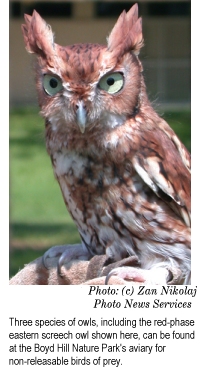
Boyd Hill Nature Park:
Discovering Nature After Sundown
by Donna Heinrich, Park Ranger
 For centuries, mystery has surrounded darkness; light representing life and darkness death. When I was a new ranger leading night hikes at Boyd Hill Nature Park in south St. Petersburg, I was amazed by the attitude of first-time night hikers. Most are uneasy and concerned for their safety. An ancient Celtic prayer always came to mind: "From ghoulies and ghosties and long-leggety beasties and things that go bump in the night, Good Lord deliver us." However, a knowledgeable interpretive guide can calm fears and provide a fascinating introduction to the workings of the night. The subject matter for night hikes can be very broad or extremely narrow. An owl prowl is a good example of the latter. For centuries, mystery has surrounded darkness; light representing life and darkness death. When I was a new ranger leading night hikes at Boyd Hill Nature Park in south St. Petersburg, I was amazed by the attitude of first-time night hikers. Most are uneasy and concerned for their safety. An ancient Celtic prayer always came to mind: "From ghoulies and ghosties and long-leggety beasties and things that go bump in the night, Good Lord deliver us." However, a knowledgeable interpretive guide can calm fears and provide a fascinating introduction to the workings of the night. The subject matter for night hikes can be very broad or extremely narrow. An owl prowl is a good example of the latter.
Almost every nocturnal creature has an image problem, including owls. People have feared and misunderstood these birds for thousands of years, associating them with death and misfortune. One need only look at the physical characteristics and behaviors of these generally nocturnal birds to begin to understand the diversity of folklore and strong reactions found in many cultures.
Their overall appearance contributes to their menacing image. A round, flat face with radiating feathers around enormous, never-moving eyes, and a sharp protruding beak makes an owl look rather humanistic. Working under the cloak of darkness also contributes to their misunderstanding. One unsettling aspect of owl behavior is their noiseless flight and their tendency to silently appear from out of nowhere. Adding to their mystique is their tendency to pierce the night with strange vocalizations. Their repertoire of calls can include bill clacks, screeches, hisses, or sounds like a rattlesnake buzzing its tail.
When threatened, owls tend to bob and weave like a prizefighter and cloak themselves like Count Dracula.
Owl prowls provide an opportunity to look for wild specimens in order to observe and explore their natural behavior. While searching their likely habitats, we share owl trivia, such as why ancient Greeks revered them for their wisdom, medieval medicinal uses of owl broth, and closer to home, Native American beliefs. In addition, we practice techniques for locating owls and their likely nest sites.
 Boyd Hill Nature Park provides additional opportunities for studying owls, such as the newly constructed non-releasable bird of prey aviary that, among other raptors, includes three species of owls. These birds are permanently crippled due to inflictions (many senseless) caused by humans, such as gunshot, exposure to poisons, and encounters with automobiles, high wires, towers and windows. Dedicated volunteers maintain these birds so that they may serve as ambassadors for those that still fly free in the wild. Boyd Hill Nature Park provides additional opportunities for studying owls, such as the newly constructed non-releasable bird of prey aviary that, among other raptors, includes three species of owls. These birds are permanently crippled due to inflictions (many senseless) caused by humans, such as gunshot, exposure to poisons, and encounters with automobiles, high wires, towers and windows. Dedicated volunteers maintain these birds so that they may serve as ambassadors for those that still fly free in the wild.
The aviary is the latest addition to an extensive bird conservation education program that has been developed over the past decade at Boyd Hill. In the last 15 years, 165 bird species have been observed utilizing this important greenspace located on the Atlantic Flyway, including 68 out of 112 neo-tropical migratory songbirds listed as imperiled species by international biologists and conservationists.Consequently, the park draws birders from throughout the United States and many other countries. The park has been part of the Florida Fish and Wildlife Conservation Commission's Watchable Wildlife Program for several years. Recently the FWCC included it in their Great Florida Birding Trail. These recognitions attest to the importance of this remnant of forest and are a credit to past city leaders that had the foresight to preserve this "jewel" as part of St. Petersburg's park system.
Boyd Hill Nature Park is open year-round (except Thanksgiving and Christmas). The park is an 800-acre oasis situated in the midst of urban St. Petersburg - the most densely populated county in the fourth-largest state in the nation. The park features approximately three miles of trails and boardwalks, which lead visitors through hardwood hammocks, sand pine scrub, pine flatwoods, willow marsh and lakeshore. In addition to night hikes, programming includes guided tours, nature walks, tram tours, children's camps, and a monthly Natural History Speaker Series. Be sure to join us soon. A night in the southern woods rekindles the magic of darkness. We'll guide you safely through the park, so you may hear the masters of the night, and if you are lucky, really lucky, you might meet one eye to eye.
Getting There
 Take I-275 to south St. Petersburg; exit at 54th Avenue S. and head east. Turn left onto 9th Street S. then left again onto Country Club Way S. and watch for park entrance on right. Take I-275 to south St. Petersburg; exit at 54th Avenue S. and head east. Turn left onto 9th Street S. then left again onto Country Club Way S. and watch for park entrance on right.
For more information on the park's bird conservation education program and ranger-led hikes, call (727) 893-7326.
Top
|



